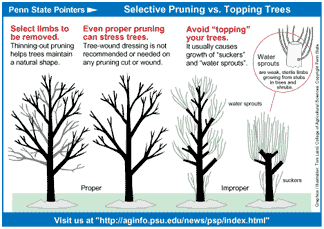|
|
|||||||||||
|
|||||||||||
|
|||||||||||
Spare Your Tree the CrewcutTopping trees distorts their shape and reduces their ability to withstand windIt’s a fable that shearing the tops of trees stops them from growing tall. Topping trees not only distorts their growth into an ugly form; it also makes them less wind resistant. If you need a tree that doesn’t grow tall, select a short species. Shop your local nursery and you’ll find small-growing trees that grow only 20 to 30 feet tall, medium size trees that grow 40 to 60 feet tall and tall-growing trees that grow 80 to over 100 feet tall. Never purchase a tall-growing species for an area with restricted height, such as under a power line. A tall-growing tree won’t be kept small using traditional pruning practices. Before long, the tree begins to look like a porcupine and you will want to cut it down. Top your deciduous tree, and you’ll find multiple branches jutting out near the cut area. Depending on the species, a single cut can result in the formation of four or more branches to develop at or just below the cut surface. If it’s a vigorous tree, you will have to prune these new sprouts within a few years, resulting in still more sprouts springing from each cut. You’ll end up with a strange-looking tree with weak branches that are less wind-tolerant, thus more susceptible to wind damage. If you fear that your tree is growing to mammoth proportions, have the branches thinned by a certified arborist, or replace it with a shorter species. An arborist can improve the appearance of the trees without encouraging trees to produce numerous sprouts while retaining its wind resistance. Recently, the Bay Gardener saw two rows of Bradford pear trees growing along a driveway on Rt. 258 into Deale that have been topped and nearly devoid of branches. To see how ugly trees can become from improper pruning, watch these trees over the next three years. Trim the right trees in the right way, and you’ll reap rewards. From Construction Site to GardenQ What steps would you take to install a garden in an area previously used as a construction holding site (severe compaction due to very heavy equipment, residue from sand, gravel, recycled concrete and mortar mix, etc.)? A First you need to scrape away as much of that mortar mix as possible. Cement will raise the pH of the soil to near the maximum of 14, and no plants can tolerate that. You must also discard as much of the recycled concrete and bluestone as possible because they will add to the pH problem. The bluestone also could be contaminated with nickel, which can be toxic to plants. To see what else is missing, have the soil tested and include tests for trace elements. Before adding those missing ingredients, apply six to eight cubic yards of compost per 1,000 square feet. To break apart the compacted soil, use a sub-soiler if there is adequate space; if not, you will have to use a trencher and fill the trenches with compost. Ask Dr. Gouin your questions at [email protected]. All questions will appear in Bay Weekly. Please include your name and address. |
|||||||||||
|
|||||||||||
|
|
|||||||||||
|
© COPYRIGHT 2007 by New Bay Enterprises, Inc. All rights reserved.
|
|||||||||||


